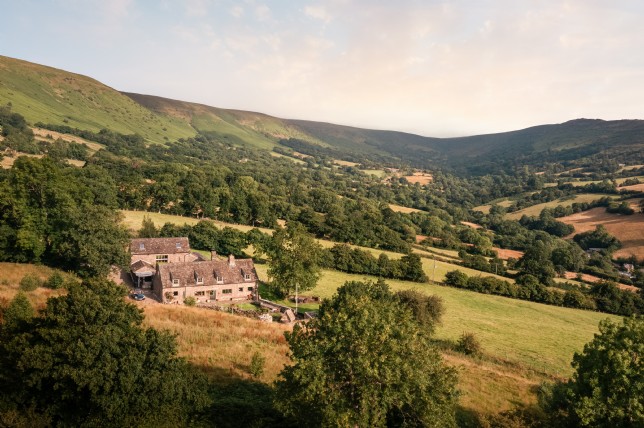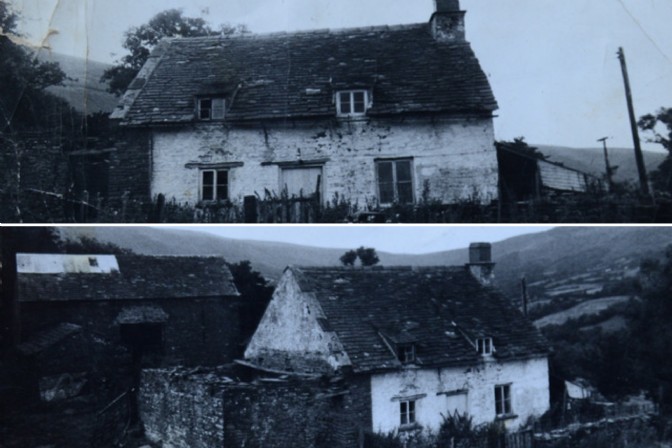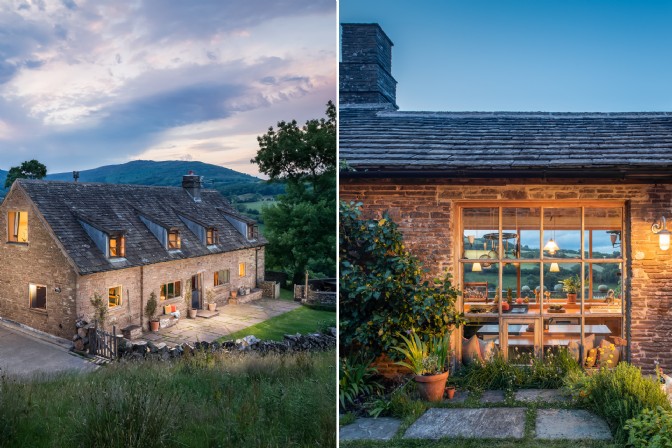We’re dedicating the month of March to “the family tree” — homes made for beloved broods, by beloved broods. In our latest chronicle, we speak with owner Henry about his mountain hideaway Charity; whose old stone walls, and the family memories forged wherein, have lovingly passed from father to son.
This sprawling, 15th-century farmhouse burrowed into the valley has views that truly stir the soul; with Wales’ Brecon Beacons and Black Mountains to one side, and rolling Herefordshire countryside to the other. Sleeping 12 guests, this is a family home as good as they get — with a snooker and cinema room, 20 acres of private land made for getting lost in, and a courtyard complete with al fresco kitchen, hot tub, and fire pit to boot. Here, we learn of its story from tumbledown cottage to tenderly-created home.
Life at this family farmhouse wasn’t always as picture-perfect as what awaits guests today. Purchased by Henry's father Ben in 1967, Charity was a derelict cottage, with the tin-roofed barn still used by the local farmer for storing hay bales over the winter. “At this time, the cottage was essentially one room which had a very basic kitchen, dining table, and sofa beside an open fire; with winding stone steps leading upstairs to two adjoining bedrooms. Originally there was no loo here but a little outdoor privy - a stone hut away from the house which perched next to the stream.” Henry, who was born some years later in the early 80s, now fondly reflects on memories spent at Charity as a boy which, at the time, were a little less luxe than what a weekend spent here now would look like. “I remember arriving in Dad’s then-two wheel drive campervan, often in the depths of winter, to a very cold and inhospitable house. Heating was always an issue and so there was a lot of firewood collecting, paraffin lamps, and candles in the evening and soup and stock-making on the go. Making the house warm and cosy was very much part of the experience."
But, along with its challenges, life at Charity during boyhood also had its immense pleasures. Henry recalls mischievous afternoons spent with his brother; where they’d create warrens inside the barn’s hay bales and build secret booby traps (“deep caverns covered with a sheet of plastic and sprinkled with hay to conceal it”) for unsuspecting adults to fall into. Living deep in the glorious Herefordshire countryside, Henry and his family often relied on the surroundings, and even nature, to provide their entertainment: “As children, during this time, our greatest wish was for snow,” Henry notes. “Every night I would go to bed praying for snow to fall.” One year stands out in particular — with snowfall so deep that he, along with his half brothers and sisters, built an entire igloo from scratch dressed as cowboys and spacemen (but of course), before proudly standing back to admire their hard work.
Henry’s parents separated in the early 90s and his father, beguiled by the beautiful, rural homes he’d seen in France but unable to prise himself away from his cherished Black Mountains, decided to purchase the outbuildings that surrounded the cottage, with plans to join them all together into one home. Henry, at the time, was at boarding school and received regular updates from his father about the progress at Charity, before returning home during the holidays to “become part of the workforce;” earning himself a penny per minute for his labour. “The hard worn toil, slowness, and attention to detail became the way of life at Charity,” he says. “There is a deep, life-affirming beauty to that which gives soul to a place.” Upon his father’s sad passing, Henry’s siblings decided to sell Charity but, as Henry notes, “with the valley and its changing moods and seasons becoming very much part of me, I knew I couldn’t let that work and this magical space slip away,” so he decided to buy his family home for himself.
With creativity running firmly through his veins thanks to his painter grandfather, designer father, and writer mother, Henry drew on his creative heritage by cleverly integrating much colour and culture into the property — a French chaise longue in green velvet here, a Welsh tapestry blanket here, a handmade chair inspired by Italian designer, Enzo Mari, there. But Charity pays homage to his family more tangibly too: with watercolour paintings by his grandfather, Edwin John, featuring throughout, one-of-a-kind, handmade creations by his father taking centre stage; from whittled wooden spoons to the old stone roof painstakingly constructed using reclaimed original tiles, and an outdoor kitchen with wood-fired oven added to the design scheme to help him embrace his inner chef; inspired by his food writer and gastronome mother, Lindsey, (plus a little extra encouragement following a binge of Netflix’s Chef’s Table).
Nowadays, when not opening the doors of Charity to guests, Henry loves nothing more than enjoying simple pleasures from his family home. Standing in the kitchen first thing in the morning with a coffee, looking across the beautiful sunlit valley. Or cooking up a storm in the courtyard on an evening underneath the moon. But, perhaps, nothing quite as delicious as his father's famous “grey slop” soup that Henry, still to this day, is trying to work out the secret to, to recreate one last time.










